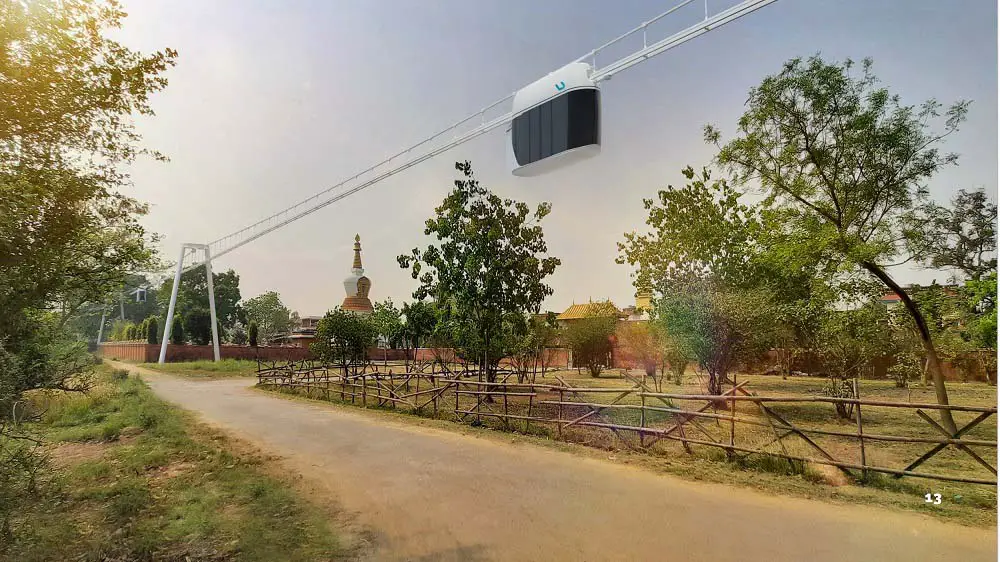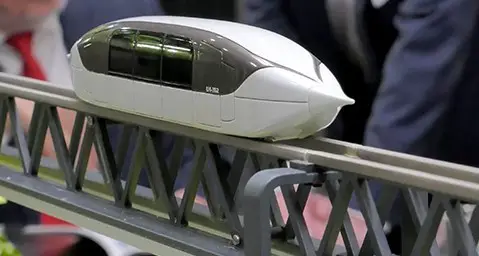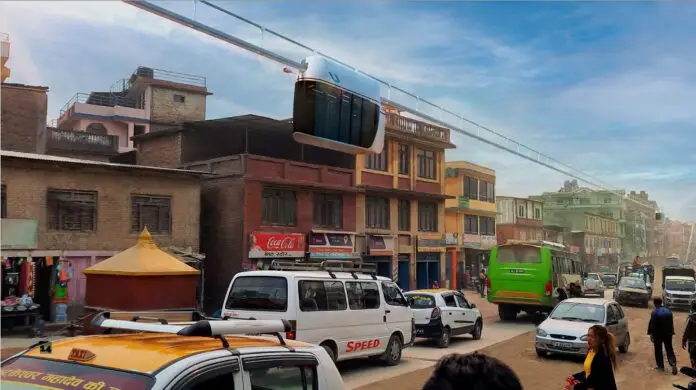Podway, the next-generation transportation system that uses pods to carry people and goods has been recognized by the government of Nepal. Now, the stakeholders can start their research, procure investment, and build the system by complying with the procedure. With the capacity of running up to 100 miles per hour, the cable-based podway system is seen as the most viable transportation option for the hill-dominated country. Kathmandu Podway Company is pushing for the implementation of podway in Nepal.
In this post, we discuss what pedway is, its benefits over traditional vehicles, and the government’s preparation to get this project underway.
Podway in Nepal
What is podway?
Podway also called micro rail is a proposed new transportation system that comprises pods running on elevated tracks. These small pods take passengers at ground-level stations and take them to their destination in a matter of seconds if not minutes. It’s a sustainable means of transportation that helps ease traffic congestion, reduce fuel imports, and improve environmental quality.
The government recognizes podway as an alternative transport in Nepal
The government of Nepal has given official recognition to Podway. Releasing a notice on the Nepali gazette (Rajpatra), the government paved the way for the formulation of the policies, standards, and regulations for the string-based eco-friendly transport system in Nepal.
Rule number 16 of the division of labor regulations under the Ministry of Physical Infrastructure and Transport mentions the “Identification, study, implementation and regulation of innovative technologies related to alternative transportation including podway, sky trolleybus, waterways.” This has legally cleared the road for Kathamndu Podway Company to start work on this alternative transport system. It’s the company that has been vouching for this Belarussian transport technology to be introduced in Nepal.
Nil Bhattarai, vice president of Kathmandu Podway was delighted with the latest development. He said, that after the procedure is formulated, we will now be able to study, operate, and build the podway system in Nepal. “The government has now recognized Podway as a public transport. Now, it has been recognized it has been interpreted as an alternative mode of public transport,” he continued. Bhattarai said that even the National Planning Commission officials gave him confidence that the podway project would be included in the 16th periodic plan.
The commission has mentioned reliable and accessible infrastructure for everyone and the transformative podway system would likely be introduced.
“This technology is not only for personal gain. The problem seen in transportation is for a solution,’ he added, ‘We have also talked to many local governments. Balen Shah, the mayor of Kathmandu metropolis, has also said that he is ready to invest Rs 2 billion in this if the law becomes a law and is implemented,” Bhattarai added. He also said that if the government makes a policy, the private sector would be ready to invest.
Kathmandu Metro is ready to invest Rs 2 billion in podway if the government recongizes it
Podway in Kathmandu
Bhattarai quipped that a podway can be built in Kathmandu in 1.5 years to mitigate traffic congestion. He elaborated, “If all goes to plan, podway will be completed within the next year and a half.”
But it’s reasonable to not fly too high. He mentioned that since nobody has taken the first initiative to build the podway in Kathmandu, there’s no concrete process as yet. However, he added that if Kathmandu Podway gets the right of way, the company could build a 100-kilometer podway in Kathmandu in 1.5 years after a detailed project report (DPR).
The technology that powers Podway
The string-based Podway transportation basically uses pods to move people between their locations. It’s a comparatively new technology, however, is powered by complex technologies:
- The pod: Pods are the vehicles that take in passengers. They are small lightweight and extremely comfortable. They are powered by electric motors. These have safety features, brakes, sensors, and an advanced communication system.
- The cable: It’s another crucial component in the podway system. The cables suspend the pods and give them the strength and ability to drive along their path. These are made of steel or other metal and are backed by a network of towers.
- The track: Track is the major infrastructure that allows pods to move. These tracks are made of steel or concrete and are usually built above the ground.
- The guidance system: The guidance system keeps pods on the track. It uses lasers to guide the pods smartly to their designated destinations.
- The control system: The control system is responsible for operating the speed and direction of the pods, and traffic monitoring. It also plays a key part in ensuring safety.
Podway either uses single or multiple cables to suspend the pods. There is another technology that uses a magnetic levitation system. The possibility for more development is wide open as it gathers more prominence for urban planners.
Also read: Why You Should Buy an Electric Vehicle in Nepal?
Podway advantages
Eco-friendly Podway transportation offers a massive range of advantages over traditional alternatives. One of the major benefits is Speed. Podway is brutally speedy. They can travel up to 100 miles (161 kilometers) per hour which greatly shortens the time it would take on buses, cars, or even trains.
Capacity: Podway can transport 50,000 passengers through the electric pods in an hour. It has the same capacity as a metro train. One pod can carry up to 40 people which translates to 50 pods carrying 2,000 passengers at a time.
podway transport can carry 50,000 passengers in an hour
Ease on traffic: Podway’s pods run on cables and offer an excellent urban transportation means. As it’s aimed at improving commuters’ daily experience in cities, pods would be a great alternative to the people away from busses and cars. Pods can be operated at a desired height with towers erected 2 kilometers apart. Just imagine how convenient it would be to travel overhead without bothering with the traffic on the road.

Eco-friendly is another hallmark. Podway is more efficient than the traditional four-wheelers. Pods run on electricity so they emit no harmful gasses into the environment. You choose pods to travel, you also do your duty to Mother Nature.
Podway offers great Comfort for passengers. Pods are small and lightweight and also very spacious. Additionally, while traveling, passengers would get a treat of panoramic view outside the window. What could be better for a mountainous country?
podsways can travel at the speed of 100 miles per hour
Safety: Pods are remotely operated by a central controlling system by computers. So, passengers are ensured of safety and well protected.
Podway benefits for passengers:
Inside the pods, the onboard passengers get various services such as:
- WiFi access
- Charging stations for electronic devices
- Food and beverage serving
- Onboard entertainment
- “Accessibility” services for passengers with disabilities
What challenges does podway face in Nepal?
Although it looks exciting, the idea of podway transport faces some hurdles including:
Cost: The cost is a huge stumbling block for implementing the podway in Nepal. To build a podway system for 10 kilometers would cost $10 million. It only requires some persuasion to get the stakeholders onboard to spend big on it because the prospects are too tempting to ignore.
Regulations: Currently, there are no regulations in place for use in Nepal. The government hasn’t yet devised plans and policies to head-start the project. However, strategies must be implemented soon so that the project gets underway.
Acceptance: Every new technology takes time to blend in. Similarly, podway’s challenge would be to draw public acceptance. Embracing a new transport system that’s technologically advanced, efficient, and so different would take some convincing for the public.
How does podway work?
Podway runs on a suspended track and works on electricity. They travel on a specified track which is supported by pillars. It’s just like the cable car system. The pods are operated by a central computer system that ensures the safe operation of pods and works to prevent any possible mishaps.
You may also want to read: Muktinath Cable Car project gets Rs 44 billion financing, 80% of the total Rs 55 billion
Where will podway be used in Nepal?
The use cases of the podway in Nepal are wide-ranging. For a hilly country such as ours, the pods can be used in a number of geographies to facilitate transport. These are the proposed areas where podway can be used:
Urban areas: In metro cities such as Kathmandu and Pokhara, using a podway could have larger-than-life benefits. It would also lessen traffic congestion and better the air quality. So using the pods for travel in cities is one of the default options to use the podway in Nepal.

Tourism hotspots: Podway can be used in tourism to transport tourists to the tourism hotspots. Also, the podway can be an object of attraction for the tourist itself.
Industrial purposes: Podway can be a great hand to transport raw materials and also the final products. Agro products are left decaying in hilly areas. The pods can transport them safely to the market in cities in a whisker.
Podway in Gokarneshwor
Kathmandu Podway Company which is the official partner of the podway technology for Nepal has been operating in Nepal four since 2019. This company is now informing the government and various concerned agencies about Poday. Vice President Bhattarai informed that feasibility studies have been done at various places for podway operation.
Despite the lack of laws and standards, there still have been some developments for podway in Nepal. Kathmandu Podway Company penned an agreement with Gokarneshwor Municipality for the operation of the podway in 2020. The plan was to build a 17 km -podway from Sundarijal to Buddha Pipalbot. For this, a feasibility study was conducted with technical teams from Belarus and Canada. But it had a major challenge.
‘The local government does not have the right to give right of way. We went with the central government. This technology should be recognized by the central government to give the right of way. We could not operate because there was no law for this,” Vice President Bhattarai said.
Likewise, studies were also conducted for areas like Ring Road, Dhobi Khola Corridor, and Grand Hospital Nagarjuna, Tokha. The company has also done a feasibility study at a distance of 100 km in different areas. Bhattarai said that soon the company will run a feasibility study in Karnali.
“Our idea is to give priority to the areas where the road network does not reach in Karnali and expand the podway. It is very convenient as people and various goods can be transported from the podway,” he said.
Podway cost in Nepal
The cost of building a podway depends greatly on the length of the route and the number of pods required. But as stated above, building a 10-kilometer-long podway system would cost $10 million.
a 10km podway transport will cost $10 million to build
That’s all the latest we have on Podway in Nepal. We will continue to update all the developments on this topic in the coming days. Keep reading Techmandu.com for all the major tech, fintech, telecom, and digital Nepal news.



